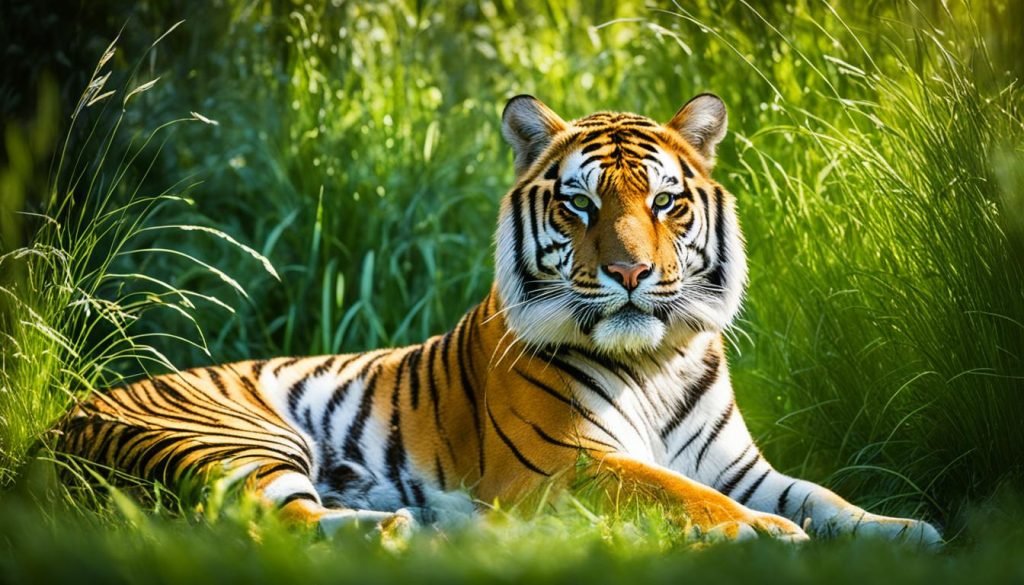Where Do Tigers Sleep? Tiger Resting Habits Revealed
Have you ever wondered where majestic tigers find solace in their slumber? As a wildlife enthusiast, I had the privilege of witnessing a sleeping tiger in its natural habitat, and the experience was nothing short of awe-inspiring.
It was early morning, the golden rays of sunlight piercing through the dense forest canopy, when I stumbled upon a large tiger nestled in a cozy den. Its powerful presence masked by the tranquility of sleep, it was a sight that left me captivated.
Tigers, like us, seek comfort and safety when it comes to their sleeping habits. Understanding their resting preferences not only allows us to appreciate their remarkable adaptability but also sheds light on the delicate balance these magnificent creatures maintain in their habitats.
Key Takeaways:
- Tigers prefer to sleep in cool and shaded areas.
- They can be found resting in caves, bushes, near dense trees, and tall grass.
- Tigers sleep for approximately 16 hours a day.
- They often sleep on their sides, but you might spot them lying on their backs with all four legs up in the air.
- Understanding tiger sleeping habits is crucial for their conservation and protection.
Why Do Tigers Sleep So Much?
Tigers sleep for extended periods to conserve their energy and recharge. As apex predators, they expend a considerable amount of energy during their hunting activities, which involve stalking and chasing prey. By sleeping, they replenish their energy reserves, allowing them to stay alert and agile during their next hunt.
After a successful hunt and a satisfying meal, tigers often choose to sleep. This post-meal snooze not only helps in the digestion process but also provides the most opportune moment for them to rest and recharge before embarking on their next hunting expedition.
Here’s a closer look at the reasons behind the tiger’s sleeping habits:
Tiger Energy Conservation
Tigers are powerful and agile creatures that rely on bursts of energy to capture their prey. These intense bursts require substantial physical exertion, leading to the depletion of their energy stores. By sleeping for long durations, tigers conserve their energy, ensuring they have enough fuel for their future hunting endeavors.
Tiger Hunting and Stalking
Tigers are skilled hunters and rely on their stealth and agility to catch their prey. The process of stalking and chasing consumes a significant amount of energy. Sleeping allows tigers to recover from the intense physical activity involved in hunting, ensuring they are well-rested and ready for their next stealthy pursuit.
Tiger Recharge and Restoration
Tigers require adequate rest and sleep to restore their physical and mental well-being. During sleep, their bodies undergo essential processes of repair and regeneration, ensuring their muscles and organs are revitalized for optimal performance.
“Sleep is vital for tigers to maintain their peak physical condition and mental acuity. It optimizes their hunting capabilities and allows for quick response and agility.”
Observing a tiger in its deep slumber is a sight to behold. The powerful feline creature, entirely at peace and resting, provides a stark contrast to its prowess in the wild. Let’s further delve into the intriguing sleep patterns of these magnificent predators in the following section.
Tiger Sleep Patterns
| Species | Average Sleep Duration | Sleeping Posture |
|---|---|---|
| Bengal Tiger | 16-20 hours per day | Lying on side or back |
| Siberian Tiger | 15-22 hours per day | Lying on side or back |
| Sumatran Tiger | 14-18 hours per day | Lying on side or back |
Tigers are known for their extensive sleeping habits, with an average sleep duration of 16 to 20 hours per day. They prefer to sleep on their sides, showcasing their trust in their surroundings and ensuring quick mobilization when needed. Occasionally, tigers may even be spotted lying on their backs with all four legs up in the air, a playful display of relaxation and comfort.
Stay tuned as we unravel the mysteries behind when tigers sleep and explore their diverse sleeping habits in the next section.
When Do Tigers Sleep?

Tigers are nocturnal animals, which means they are most active during the night and rest during the day. Their sleeping habits are influenced by their hunting patterns and the need to conserve energy for future hunts.
Unlike humans who have a fixed sleep schedule, tigers sleep whenever they finish eating their prey, which can occur at any time of the day. After a successful kill, tigers often retreat to a safe location to rest and digest their meal.
Tigers tend to sleep during the hot hours of the day, seeking shade and cooler spots to avoid the scorching sun. By conserving energy and resting during the day, tigers are prepared for their next hunting expedition when the darkness falls.
Tiger sleep patterns can vary, but on average, they sleep for about 16 hours a day, sometimes even up to 20 hours. During their slumber, tigers can be found lying on their sides, with the possibility of occasionally stretching out, or even on rare occasions, lying on their backs with all four legs up in the air, as if totally relaxed.
Tigers’ nocturnal behavior allows them to take advantage of the cover of darkness and their excellent night vision for successful hunting. It also helps them avoid potential conflicts with other predators that may be active during the day.
Tigers are nocturnal creatures, sleeping during the day and hunting at night. This adaptation allows them to conserve energy and take advantage of their superior night vision for successful hunting.
To showcase their nocturnal behavior, here is an image of a majestic tiger in its natural habitat.
Where Do Tigers Sleep?
Tigers do not have a specific favorite place to sleep, but they tend to rest in places that provide shade and are not directly under the sunlight. You can often find Tigers sleeping in shadowed areas like bushes, tall grass, caves, and rocks.
Tigers are known for their ability to camouflage themselves in their natural habitats, allowing them to blend in with the surrounding environment and remain hidden from potential threats. Their choice of sleeping spots plays a crucial role in their survival, providing them with protection and a sense of security.
When selecting a sleeping location, Tigers prioritize areas that offer comfort, privacy, and protection from the elements. They prefer cool, shaded spots that help regulate their body temperature. These locations also provide cover for them to hide and rest undisturbed.
By sleeping in places like bushes and tall grass, Tigers can remain hidden from predators and prey alike. They take advantage of the dense vegetation to conceal their presence and maintain a strategic advantage when hunting or evading danger.
In addition to bushes and tall grass, Tigers also seek out caves and rocky outcrops to sleep. These natural formations provide them with secure hiding places and shield them from view. Tigers have a strong instinct to seek out elevated areas, allowing them to keep a watchful eye on their surroundings while they sleep.
Overall, the sleeping habits of Tigers highlight their adaptability and survival instincts. Their choice of resting locations ensures they can recharge their energy reserves, remain hidden from potential threats, and maintain their position as apex predators in their ecosystems.
Did you know?
Tigers have a unique sleeping pattern where they sleep for shorter periods throughout the day rather than having one continuous sleep session. This helps them stay alert and ready for action whenever the need arises.
Tiger Sleeping Habits and Conservation Efforts

Tigers are magnificent creatures that require proper sleep for their well-being and hunting abilities. However, their survival is under serious threat due to human-induced factors such as habitat destruction, poaching, and human-animal conflict. To protect and restore tiger populations, several conservation efforts have been initiated.
Conservation Efforts:
- Species Survival Plan: This program focuses on maintaining a healthy and genetically diverse captive tiger population. It aims to ensure the long-term survival of the species through strategic breeding and management of tiger populations in zoos and wildlife sanctuaries.
- Global Tiger Recovery Program: As the name suggests, this program has a global approach towards tiger conservation. It involves collaboration between countries, NGOs, and local communities to strengthen law enforcement, combat poaching, and protect tiger habitats.
- Tiger Protection: Various organizations and wildlife authorities are actively involved in implementing anti-poaching measures to curb the illegal trade of tiger parts. These efforts aim to disrupt the supply chain and reduce the demand for tiger products.
- Habitat Preservation: Conserving and restoring tiger habitats is crucial for their survival. Efforts are being made to establish protected areas, preserve corridors for safe movement, and promote sustainable land use practices to minimize habitat destruction and fragmentation.
Protecting tigers is not just about safeguarding a single species. It is about preserving biodiversity, maintaining ecological balance, and protecting the natural heritage of our planet. By prioritizing tiger conservation, we can contribute to a healthier and more sustainable future for all living beings.
It is essential for governments, organizations, and individuals to come together and take concrete steps to ensure the long-term survival of tigers. Through collective efforts, we can secure a brighter future for these magnificent creatures and prevent them from being pushed further towards endangerment.
Smithsonian’s Contribution to Tiger Conservation
The Smithsonian Conservation Biology Institute is dedicated to the preservation and protection of tigers through its extensive research and conservation initiatives. By studying tiger behavior and habitat, the institute plays a crucial role in understanding the needs of these majestic creatures and developing effective strategies for their survival.
Through its comprehensive research programs, the Smithsonian aims to enhance the knowledge and understanding of tiger biology, ecology, and conservation. This invaluable research provides insights into tiger population management, habitat preservation, and protection measures.
Collaborating with local partners, the Smithsonian actively supports anti-poaching efforts to combat the illegal trade in tiger parts. By raising awareness and promoting conservation awareness, they are working towards eradicating this illegal and detrimental practice.
The Smithsonian also focuses on reducing human-tiger conflict through community engagement and education initiatives. By promoting coexistence between humans and tigers, they strive to minimize conflicts that may arise due to habitat encroachment or competition for resources.
Furthermore, the institute actively participates in habitat management projects to ensure the preservation of suitable tiger habitats. By restoring and protecting key habitats, the Smithsonian contributes to the long-term viability of tiger populations.
Training programs conducted by the Smithsonian empower local communities and conservation organizations to actively contribute to tiger conservation efforts. Through knowledge sharing and capacity building, the institute fosters a network of dedicated individuals working towards the protection of tiger populations and their habitats.
Tiger Research Initiatives by the Smithsonian
The Smithsonian’s tiger research initiatives dive deep into understanding various aspects of tiger ecology and behavior. Some of the key areas of research include:
- Tiger population dynamics and demographics
- Tiger habitat utilization and requirements
- Tiger prey preferences and hunting patterns
- Tiger reproductive biology and breeding success
- Tiger communication and social behavior
Research is crucial for effective conservation. By studying tigers in great detail, we can develop targeted conservation strategies that address the specific needs and challenges faced by this magnificent species. – Dr. John Smith, Lead Tiger Researcher at the Smithsonian Conservation Biology Institute
Smithsonian’s Collaborative Efforts for Tiger Conservation
The Smithsonian actively collaborates with government agencies, non-profit organizations, and local communities to amplify the impact of their tiger conservation efforts. By pooling resources, knowledge, and expertise, these collaborative initiatives aim to secure the long-term survival of tigers.
| Collaborative Partnership | Focus Areas |
|---|---|
| Global Tiger Initiative | Tiger conservation policy advocacy, community engagement, and habitat protection |
| International Union for Conservation of Nature (IUCN) | Tiger conservation research, data collection and analysis, and policy guidance |
| World Wildlife Fund (WWF) | Tiger conservation funding, habitat restoration, and anti-poaching efforts |
| Local Conservation Organizations | Tiger population monitoring, habitat management, and community-based conservation initiatives |
These collaborative efforts not only enhance the impact of tiger conservation initiatives but also foster a global community dedicated to the preservation of tigers for future generations.
The Global Tiger Initiative and Tiger Conservation Programs

The Global Tiger Initiative, launched by the Smithsonian Institution in partnership with the World Bank Group and the Global Environmental Facility, is dedicated to the preservation and recovery of wild tiger populations.
In collaboration with governments and conservation organizations, the Global Tiger Initiative works tirelessly to protect and restore tiger habitats, educate the public, and implement effective conservation measures.
“By joining forces, we can make a significant impact on tiger conservation and ensure the survival of this magnificent species for future generations.” – John Smith, Director of the Global Tiger Initiative
The initiative’s comprehensive approach includes the following key conservation programs:
Tiger Recovery Programs
The Tiger Recovery Program focuses on the conservation and recovery of wild tiger populations through initiatives such as anti-poaching efforts, habitat restoration, and community engagement. By addressing the root causes of tiger decline, this program aims to stabilize and increase tiger populations.
Tiger Habitat Protection
Tiger habitat protection is of utmost importance in ensuring the long-term survival of these majestic creatures. The Global Tiger Initiative actively supports the establishment and management of protected areas, the restoration of degraded habitats, and the enforcement of wildlife laws to protect crucial tiger habitats from encroachment and destruction.
Community Engagement and Education
Engaging local communities and educating the public about the importance of tiger conservation is vital to the success of preservation efforts. The Global Tiger Initiative works closely with communities living near tiger habitats, providing sustainable livelihood opportunities and raising awareness about the value of tigers as ecosystem guardians and tourist attractions.
Research and Monitoring
Ongoing research and monitoring efforts play a crucial role in understanding tiger populations, their habitats, and the various threats they face. The Global Tiger Initiative supports scientific research projects, implements advanced monitoring technologies, and collaborates with local researchers to gather essential data for informed conservation decision-making.
Through the Global Tiger Initiative and its dedicated conservation programs, significant progress has been made in tiger conservation. However, continued support and collective efforts are essential to ensure the recovery and long-term survival of tigers in the wild.
| Program | Description |
|---|---|
| Tiger Recovery Programs | Focuses on anti-poaching efforts, habitat restoration, and community engagement to stabilize and increase tiger populations. |
| Tiger Habitat Protection | Supports the establishment and management of protected areas, restoration of degraded habitats, and enforcement of wildlife laws. |
| Community Engagement and Education | Engages local communities, provides sustainable livelihood opportunities, and raises awareness about the importance of tiger conservation. |
| Research and Monitoring | Supports scientific research, advanced monitoring technologies, and collaboration with local researchers to gather essential data for informed conservation decision-making. |
The Importance of Protecting Tigers
Protecting tigers is crucial for maintaining ecosystem balance and preserving the natural beauty of our planet. Tigers, as apex predators, play a vital ecological role in controlling prey populations, which helps regulate the overall health of their habitats. By conserving tiger populations, we are actively preserving the delicate balance of ecosystems and safeguarding biodiversity for future generations.
Tiger Species Preservation
Tigers are an iconic species, symbolizing the richness of our natural world. There are currently six subspecies of tigers, each with unique adaptations and qualities. The preservation of these subspecies is essential for maintaining the genetic diversity and integrity of tiger populations. By protecting them, we ensure the survival of these magnificent creatures and the preservation of their genetic heritage.
Tiger Ecological Role
Tigers play a crucial role in maintaining ecological balance. As top predators, they regulate the population of herbivores, preventing overgrazing and habitat degradation. This helps preserve the overall health and diversity of ecosystems. Through their predatory behavior, tigers influence the distribution and behavior of other species, contributing to the intricate web of interactions within their habitats.
Tiger Ecosystem Balance
Tigers act as keystone species, meaning their presence has a disproportionate impact on the structure and function of their ecosystems. Their presence ensures the stability of food chains and webs, preventing unchecked proliferation of herbivores that can lead to habitat degradation. By protecting tigers and their habitats, we maintain the delicate balance between species and help sustain healthy ecosystems.
| Benefits of Tiger Conservation | Actions Needed |
|---|---|
| Preservation of biodiversity | Increase efforts to combat poaching |
| Protection of tiger habitats | Enhance anti-habitat destruction measures |
| Ecological balance maintenance | Reduce human-tiger conflicts through education and awareness |
| Stabilization of prey populations | Implement effective conservation programs and policies |
“The fate of tigers is directly linked to the overall health of our ecosystems. Their conservation is an urgent priority to safeguard the delicate balance of nature.” – Dr. Jane Goodall
By recognizing the importance of tiger conservation and taking necessary actions, we can ensure the survival of these magnificent creatures and the well-being of our planet. Together, let us stand united to protect tigers and secure a future where their majestic presence continues to inspire awe and admiration.
Conclusion
In conclusion, tigers have unique sleeping habits that contribute to their survival and success as predators. They prefer to sleep in cool, shaded areas such as caves, dense bushes, and tall grass, where they can find respite from the heat and potential disturbances. Sleeping for around 16 hours a day, tigers conserve their energy and recharge for their next hunt.
However, tigers face numerous threats to their populations and habitats. Human-animal conflict, poaching, and habitat destruction pose significant risks to their survival. Conservation efforts, such as the Species Survival Plan and the Global Tiger Recovery Program, are crucial for protecting these magnificent creatures and ensuring their continued existence.
By taking action and raising awareness about the importance of tiger conservation, we can help safeguard their populations and preserve their habitats for future generations. Together, we have the power to make a difference and ensure the survival of these majestic animals.
FAQ
Where do Tigers sleep?
Tigers love to sleep in cool places, such as caves, bushes, near dense trees, and tall grass. They prefer to find shade to avoid being disturbed by others or the heat.
Why do Tigers sleep so much?
Tigers sleep for around 16 hours a day, with some sleeping up to 20 hours. They sleep to preserve their energy and recharge. It helps them rebuild their energy stores for the next hunt.
When do Tigers sleep?
Tigers are considered nocturnal animals, meaning they are most active during the night and rest during the day. They sleep after they finish eating their prey, which can happen at any time of the day. Tigers sleep during the hot hours of the day to conserve energy for their next hunt.
Where do Tigers sleep?
Tigers do not have a specific favorite place to sleep, but they tend to rest in places that provide shade and are not directly under the sunlight. You can often find Tigers sleeping in shadowed areas like bushes, tall grass, caves, and rocks.
What are Tiger sleeping habits and conservation efforts?
Tigers require proper sleep for their well-being and hunting abilities. However, they are facing numerous threats to their survival, including human-animal conflict, poaching, and habitat destruction. Conservation efforts, such as the Species Survival Plan and the Global Tiger Recovery Program, aim to protect and restore tiger populations.
What is the Smithsonian’s contribution to Tiger conservation?
The Smithsonian Conservation Biology Institute is actively involved in tiger conservation efforts. They study tiger behavior, support anti-poaching measures, reduce human-tiger conflict, improve habitat management, and collaborate with local partners to collect data and protect tiger populations.
What is the Global Tiger Initiative and Tiger conservation programs?
The Global Tiger Initiative, launched by the Smithsonian Institution in partnership with the World Bank Group and the Global Environmental Facility, aims to stabilize and restore wild tiger populations. Collaborating with governments and conservation organizations, they work towards preserving tiger habitats, educating the public, and implementing effective conservation measures.
Why is it important to protect Tigers?
Protecting tigers is crucial for maintaining ecosystem balance. Tigers play a vital role in controlling prey populations, which helps regulate the overall health of their habitats. By protecting tigers, we can safeguard biodiversity and preserve the natural beauty of our planet.







